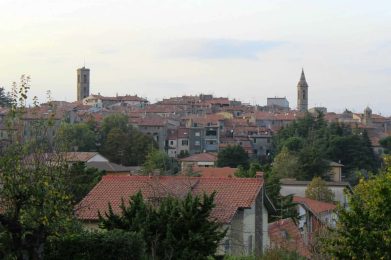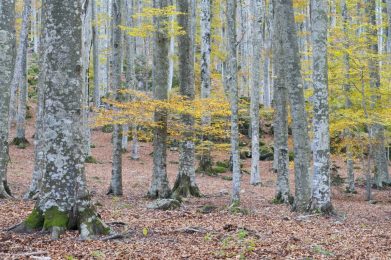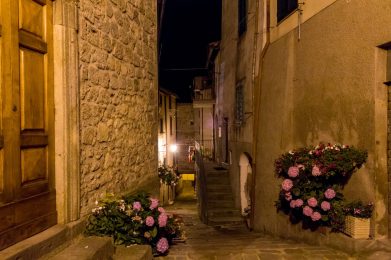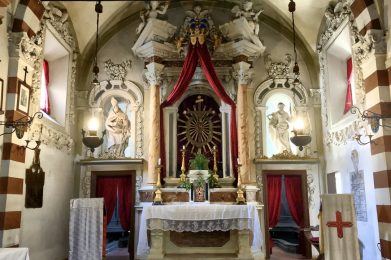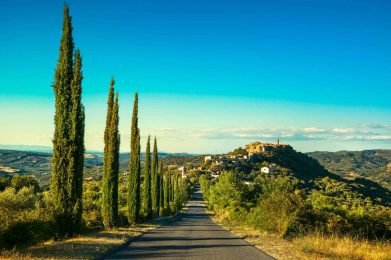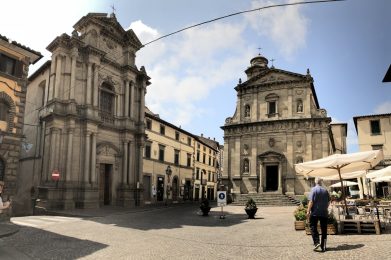The village of Castel del Piano is situated on the hilly spurs of Monte Amiata. The territory is characterized by the presence of olive groves and vineyards, which give an excellent oil and an excellent wine and are protected and valued respectively by the Consortium for the protection of the oil of Olivastra Seggianese and from the Montecucco Wine Trail.
Immagini del borgo
History
The earliest record of Castel del Piano comes from a document of the Abbey of San Salvatore from the year 890, where it is named as Casale Plana. In 1175 it became a castle (castrum plani) of the Counts Aldobrandeschi of the Santa Fiora branch, and in 1198 it is found called Plana Ferraria, probably due to the iron-colored rocks above the plateau. In 1330 the Aldobrandeschi ceded half the town to Siena, which the following year was finally conquered by the city of the Palio, after a siege commanded by the mercenary captain Guidoriccio da Fogliano.
Castel del Piano remained under the rule of Siena until 1559, when it was annexed into the Grand Duchy of Tuscany. During this period the town experienced a strong artistic and cultural growth, with the construction of Renaissance noble palaces and especially the presence of numerous artists who founded a real school, such as the Nasini dynasty of Baroque painters. In the 19th century, the people of Castel del Piano took an active part in the Risorgimento uprisings. During World War II, Castel del Piano saw the passage of the Allied front and General De Gaulle stopped here. In 1965 the historic plant for the production of tannic acid, an important economic resource of the area, closed, but almost at the same time the municipality discovered a new and important resource: winter tourism, thanks to the opening of the first ski lifts at Macinaie and Contessa, which are still popular today.
What to see
On the main square of Castel del Piano, known as “della Madonna”, is the Church of the Opera or Propositura dei Santi Niccolò e Lucia, a Baroque temple completed only in 1870. On the corner with the Church of the Opera is that of the Madonna delle Grazie while to its right is the Town Hall.
Going up to the oldest part of the village one passes under the arch supporting Torre dell’Orologio, beyond which it is worth lingering in the picturesque Piazzetta degli Ortaggi, endowed with a beautiful 16th-century Loggia; the austere Pieve di San Leonardo is also worth a visit. At the opposite end of the village, on the other hand, is the “Chiesa Piccina”, or of the Blessed Sacrament. In the heart of Piazza Garibaldi, better known as Piazza Tonda or delle Storte, there is an interesting fountain, but the element that makes it special in the eyes of the inhabitants is the fact that it is here, every September 8, that the coveted Palio is contested.
Village of Castel del Piano
Municipality of Castel del Piano
Province of Grosseto
Region Tuscany
Inhabitants: 4.822 casteldelpianese
Altitude center: 637 m a.s.l.
The Municipality is part of:
City of wine
City of oil
Starada Wine Montecucco and flavors of Amiata
Municipality
Via Marconi, 9 – Tel. 0564 973511
BY CAR
- From the North: Take the A1 highway, exit at Firenze Certosa, take the Firenze – Siena highway towards Siena, after Siena continue towards Grosseto until Paganico, then follow the directions for Castel del Piano.
- From the south: Take the A1 highway, exit at Orvieto, follow the direction for Castel San Giorgio and then Acquapendente, take the SS 2 Cassia towards Siena, at Ponte a Rigo turn towards Piancastagnaio, pass the town and follow the directions for Castel del Plan.
- From Rome: take the A12 motorway in the direction of Civitavecchia, continue on the SS 1 Aurelia in the direction of Grosseto, continue on the highway to Grosseto until Paganico, then follow the indications for Castel del Piano.
ON THE TRAIN
- Civitella-Paganico railway station
BY PLANE
- Florence Airport
- Pisa Airport
- Rome Fiumicino Airport

